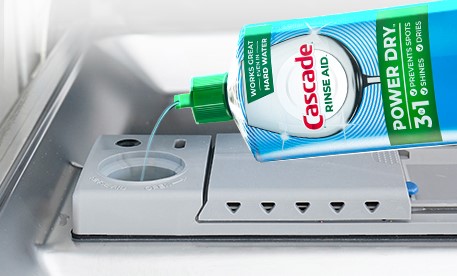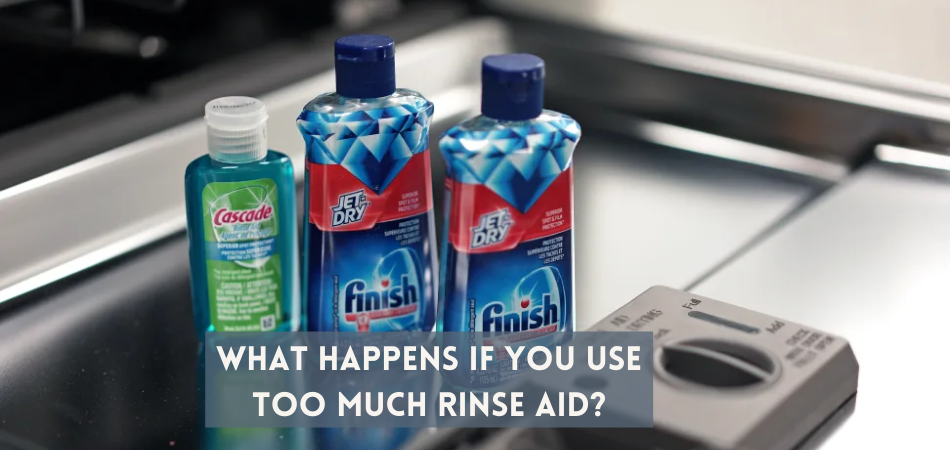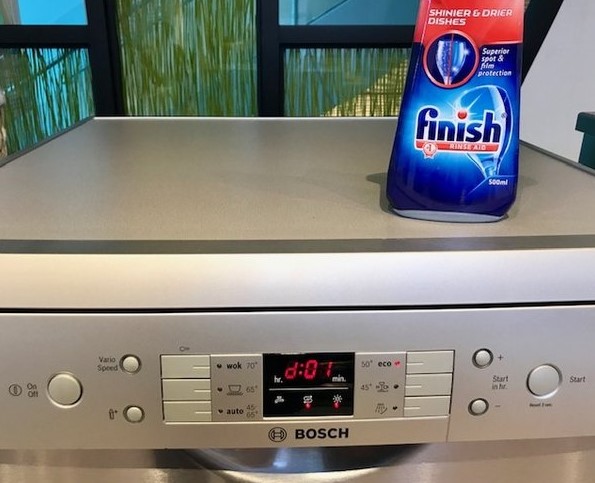A dishwasher rinse aid is a must-have for every household. It is the best aid to make your plates, and household utensils look sparkling clean. But what happens if you use too much rinse aid? Are these cleaning products safe for use in your household? Are rinse aids necessary in your home?
But what some people do not know is that if you excessively use rinse aid; they sometimes remain on the dishes. This means that your family may be ingesting a little amount of this dishwasher rinse aid anytime they eat. But is that okay, or what should you do? Read on to know more!
Contents
What Is Dishwasher Rinse Aid And Is It Necessary?
You may not have noticed it yet, but in every dishwasher machine, there is a special compartment for the rinse aid. This aid assists your machine produces a spotless result. A dishwasher rinse aid improves the drying process of your utensils and safeguards them from etching. In almost every present-day dishwasher machine you see, especially Dishwashers for Septic Systems, there is always a compartment for rinse aid. That is because it comes with certain benefits. Such as;
- sparkling dishes, especially glassware
- Improved and more efficient drying
- Protecting your glassware from marks and etching
Is it Necessary?
It is quite clear that dishwasher rinse aid has great advantages, but is it a necessity while washing? The answer is no! Its formula doesn’t affect the dishwashing process. This means that what your machine actually needs to operate effectively is the detergent.
With the detergent, your machine can sanitize and clean your dishes to be free from residual debris and food scraps. However, rinse aid is good to be handy, especially when you have to entertain guests at nighttime.
You will want to use the rinse aid ahead of time to get really shining wine glasses, dishware, and silver. But you can still do without it, especially when it means exposing your household to chemicals.
How Much Rinse Aid Is Enough?
According to some manufacturers, the amount of rinse aid you need is 3.5 drops of the substance. That is, for every dishwasher cycle you undertake. One drop of the rinse aid is technically 0.05ml.
This means that for each dishwashing cycle, you are using around 0.175 milliliters rinse aid. However, it is advisable to use a rinse aid agent dispenser. Since you will want effective drying from your dishwasher, it is important to fill the agent dispenser before using the machine.
When the dispenser fills up to the brim, it can contain around 5oz, which equals 150-175ml of the rinse aid, which can last up to 1 month. If you want to know when your dishwasher has enough rinse aid, check out the optical level indicator color. It is located closer to the cover.
How Do You Know When Your Rinse Aid Is Full?
Next to the rinse aid fill cover, there are 3 indicator lenses. The biggest lens among them that displays your rinse aid color shows that the reservoir is full. That is why; when the container of the rinse aid is full, the entire indicator will completely turn to black.
When you are using the rinse aid, the lens will begin to display a silver or clear color. That is to show that the rinse aid is diminishing. When it gets to the extent that the tiniest lens of your dishwasher is indicating a silver or clear color, you should know that the time has come for you to refill. You can refill your dispenser through the following steps;
- Press down on the sanitize button to choose the menu for rinse aid level fixing.
- Press on the automatic cycle button to reset its setting.
- Choose from d1 – d5 that is from the lowest level to the highest level
- Allow 5 seconds to elapse, and you can then save the level you set.
What Happens If You Use Too Much Rinse Aid?
Dishwasher rinse aid is actually a surfactant that minimizes the liquid surface tension. As a result, it can assist in terminating excessive water from the dishware and providing flawless drying. It is an effective and helpful invention you can use with your dishwashing machine, especially when it isn’t chemical-pact. But no matter how good the rinse aid is at enhancing washing results, it’s not good to overuse it.
There is always a compartment specially designed to accommodate rinse aid in every dishwasher. This compartment is supposed to receive the right amount of filling. But some people mistakenly apply too much of the rinse aid. And this can lead to certain results you won’t appreciate from such a situation.
Some of them include:
- Excessive foaming: Using too much rinse aid can result in foaming, which will in turn cause overflowing. Also, it may cause the dishwasher to clog its filter outlet and, most times, destroy the septic tank.
- Greasy results: Furthermore, your glassware is likely to come out with grease. That is because too much rinse aid can induce a layer of film or cloud on the glassware, to be precise. This can really lead to mayhem!
- Ingestion of toxic materials: Do you know that rinse aid contains many toxic ingredients? Some of them include Zinc Chloride, Tetrasodium EDTA, Sodium Silicate, Benzenesulfonic acid, Sodium Hydroxide, etc. While these ingredients might not be carcinogens, prolonged exposure is not good.
- Health issues: While using rinse aid helps to improve our washing results, the chemicals used in them are not good for ingestion. The problem here is not that you used the aid, but excessive use means more exposure to the toxic chemicals. When your family keeps ingesting these chemicals, it can cause some health issues such as diarrhea, eye damage, vomiting, etc.
What To Do After Excessive Application Of Rinse Aid?
So let’s say you’ve mistakenly added excess rinse aid to your dishwasher and doesn’t want to experience the negative effects above; you can do the following things:
- Stop the washing cycle: Once you see that excess foam is coming out of the dishwasher, it means that the rinse aid you added is too much. So stop the cycle immediately to allow water to drain and prevent spillage.
- Add salt: After all the water has drained off the dishwasher, bring out the rack below and check for more foams. If there’re still some thick ones remaining, put salt into the dishwasher to break down the foams.
- Clean with a towel: Now that all the foams are out, pick your towel to clean the inside and outside of the dishwasher.
- Run another cycle: This will be a rinse circle to check if all the foams are out of the dishwasher. Once you’re done and find no foam coming out, then you’re done. But if not, start again to repeat the processes above. Don’t forget to check the cap of the rinse aid dispenser to ensure it is not leaking.
Tip To Avoid Putting More Rinse Aid
For you to avoid putting more rinse aid than the required amount, you will have to know the adequate amount to put. That is why; you take some precautions based on how to use it.
Use The Indicator
You should fill the rinse aid container to the brim until its indicator shows that it is completely full. When you are done with one dishwasher cycle, you can decide whether it performed effectively or not. If it happens that the utensils didn’t dry properly or that there is a white film on them, you can reset the auto setting of your rinse aid to a higher level.
The indicator that shows when the machine is full only displays when the compartment is loaded fully. This means that it will not display when the load isn’t full or half full. Although some dishwashers that have the Smart mechanism can actually detect the level of rinse aid filled and work with that.
Start With Small Amounts
It is not everybody that can afford a Smart dishwasher machine. So in this situation, what you can do is follow the rule “little is often more.” No two dishwashers are the same. As a result, there is no specified amount of rinse aid to use. So, you should begin with small amounts of the rinse aid and watch how it performs. If the functioning isn’t effective, you add a little more to it.
When using a dishwasher, your best friend should be trial and error. That is the best way you can arrive at the appropriate measurement.
Understand The Dishwasher Tablets/pacs
If you are making use of dishwasher tablets/pacs, most times, they come together with a detergent combo, salt, and rinse aid. Due to reasons best known to the manufacturer, certain tablets only come with detergents. These detergents also assist the drying process and keep the dishware streak-free.
But sometimes filling the rinse aid as it is supposed to be may lead to super-massive suds, which may turn to excess rinse aid. The reason is due to the type of tablets or pacs. Usually, the natural types contain ingredients such as sodium polyaspartate or sodium aluminosilicate. Sodium aluminosilicate keeps things fully dry, while sodium polyaspartate is an anti-filming synthetic agent. The combination of the 2 substances allows the dishwasher to work more effectively in keeping your utensils stain-free.
However, some brands of dishwasher detergents make use of these substances and other similar types of them in large quantities. That is why; you get the problem of applying excess rinse aid. So when ordinary users like us just adhere to the instructions.
You may not have the time to carry out thorough research just so that you can clean your dishes. Moreover, brands do not always expose the ingredients they use to cover their trade secrets.
So when the case is like this, how can you stop applying too much rinse aid?
If you only decide to use the natural tablets, you can do the following;
- For the initial; 2-3 loads, don’t make use of the rinse aid.
- If you are making use of the natural detergents, you will have to wait for at least 3 days to you to decide whether they are working effectively or not.
- After the third cycle, you can check the efficiency of the detergent
- If the detergent performs effectively on its own and is streak-free, you can forget about adding any rinse aid and vice versa.
- Experience is the best teacher. So if there is a need for a rinse aid, make sure not to fill the container.
There is always an exception to the case, though, and that is smart dishwashers. They do not operate when the indicator of the dishwasher is displaying fully. Smart dishwashers will never run with too much rinse aid, of course.
Conclusion
After reading through this article, you know what happens if you use too much rinse aid. Even though the rinse aid is not a detergent, if you use it too much, you will likely get the result you are not expecting.
There is the possibility that you will see excessive suds, which will impact the draining performance of the dishwasher. Not only that, it may negatively affect your dishwashing machine thus causing it to clog its filter and outlets.





